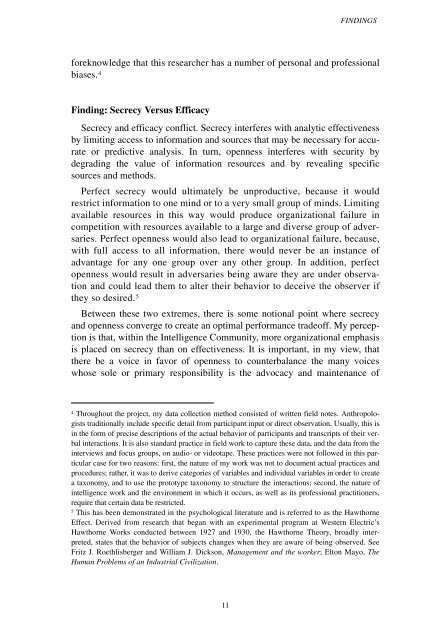Analytic Culture in the U.S. Intelligence Community (PDF) - CIA
Analytic Culture in the U.S. Intelligence Community (PDF) - CIA
Analytic Culture in the U.S. Intelligence Community (PDF) - CIA
Create successful ePaper yourself
Turn your PDF publications into a flip-book with our unique Google optimized e-Paper software.
FINDINGS<br />
foreknowledge that this researcher has a number of personal and professional<br />
biases. 4<br />
F<strong>in</strong>d<strong>in</strong>g: Secrecy Versus Efficacy<br />
Secrecy and efficacy conflict. Secrecy <strong>in</strong>terferes with analytic effectiveness<br />
by limit<strong>in</strong>g access to <strong>in</strong>formation and sources that may be necessary for accurate<br />
or predictive analysis. In turn, openness <strong>in</strong>terferes with security by<br />
degrad<strong>in</strong>g <strong>the</strong> value of <strong>in</strong>formation resources and by reveal<strong>in</strong>g specific<br />
sources and methods.<br />
Perfect secrecy would ultimately be unproductive, because it would<br />
restrict <strong>in</strong>formation to one m<strong>in</strong>d or to a very small group of m<strong>in</strong>ds. Limit<strong>in</strong>g<br />
available resources <strong>in</strong> this way would produce organizational failure <strong>in</strong><br />
competition with resources available to a large and diverse group of adversaries.<br />
Perfect openness would also lead to organizational failure, because,<br />
with full access to all <strong>in</strong>formation, <strong>the</strong>re would never be an <strong>in</strong>stance of<br />
advantage for any one group over any o<strong>the</strong>r group. In addition, perfect<br />
openness would result <strong>in</strong> adversaries be<strong>in</strong>g aware <strong>the</strong>y are under observation<br />
and could lead <strong>the</strong>m to alter <strong>the</strong>ir behavior to deceive <strong>the</strong> observer if<br />
<strong>the</strong>y so desired. 5<br />
Between <strong>the</strong>se two extremes, <strong>the</strong>re is some notional po<strong>in</strong>t where secrecy<br />
and openness converge to create an optimal performance tradeoff. My perception<br />
is that, with<strong>in</strong> <strong>the</strong> <strong>Intelligence</strong> <strong>Community</strong>, more organizational emphasis<br />
is placed on secrecy than on effectiveness. It is important, <strong>in</strong> my view, that<br />
<strong>the</strong>re be a voice <strong>in</strong> favor of openness to counterbalance <strong>the</strong> many voices<br />
whose sole or primary responsibility is <strong>the</strong> advocacy and ma<strong>in</strong>tenance of<br />
4<br />
Throughout <strong>the</strong> project, my data collection method consisted of written field notes. Anthropologists<br />
traditionally <strong>in</strong>clude specific detail from participant <strong>in</strong>put or direct observation. Usually, this is<br />
<strong>in</strong> <strong>the</strong> form of precise descriptions of <strong>the</strong> actual behavior of participants and transcripts of <strong>the</strong>ir verbal<br />
<strong>in</strong>teractions. It is also standard practice <strong>in</strong> field work to capture <strong>the</strong>se data, and <strong>the</strong> data from <strong>the</strong><br />
<strong>in</strong>terviews and focus groups, on audio- or videotape. These practices were not followed <strong>in</strong> this particular<br />
case for two reasons: first, <strong>the</strong> nature of my work was not to document actual practices and<br />
procedures; ra<strong>the</strong>r, it was to derive categories of variables and <strong>in</strong>dividual variables <strong>in</strong> order to create<br />
a taxonomy, and to use <strong>the</strong> prototype taxonomy to structure <strong>the</strong> <strong>in</strong>teractions; second, <strong>the</strong> nature of<br />
<strong>in</strong>telligence work and <strong>the</strong> environment <strong>in</strong> which it occurs, as well as its professional practitioners,<br />
require that certa<strong>in</strong> data be restricted.<br />
5<br />
This has been demonstrated <strong>in</strong> <strong>the</strong> psychological literature and is referred to as <strong>the</strong> Hawthorne<br />
Effect. Derived from research that began with an experimental program at Western Electric’s<br />
Hawthorne Works conducted between 1927 and 1930, <strong>the</strong> Hawthorne Theory, broadly <strong>in</strong>terpreted,<br />
states that <strong>the</strong> behavior of subjects changes when <strong>the</strong>y are aware of be<strong>in</strong>g observed. See<br />
Fritz J. Roethlisberger and William J. Dickson, Management and <strong>the</strong> worker; Elton Mayo, The<br />
Human Problems of an Industrial Civilization.<br />
11
















